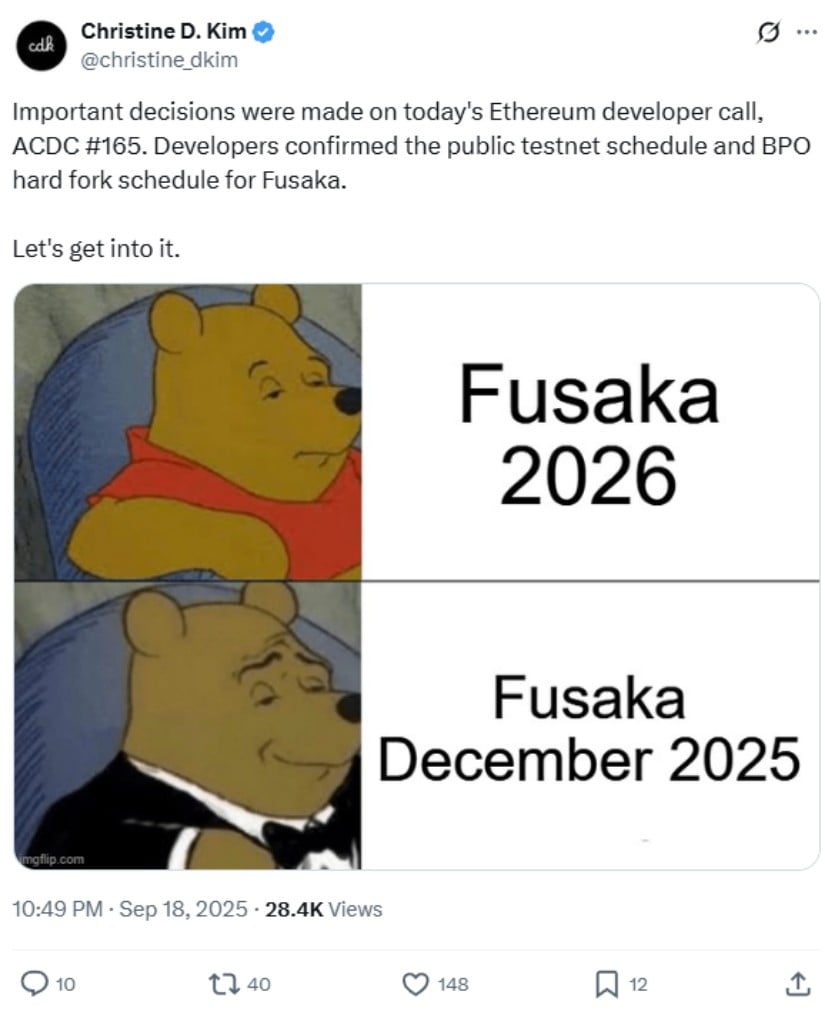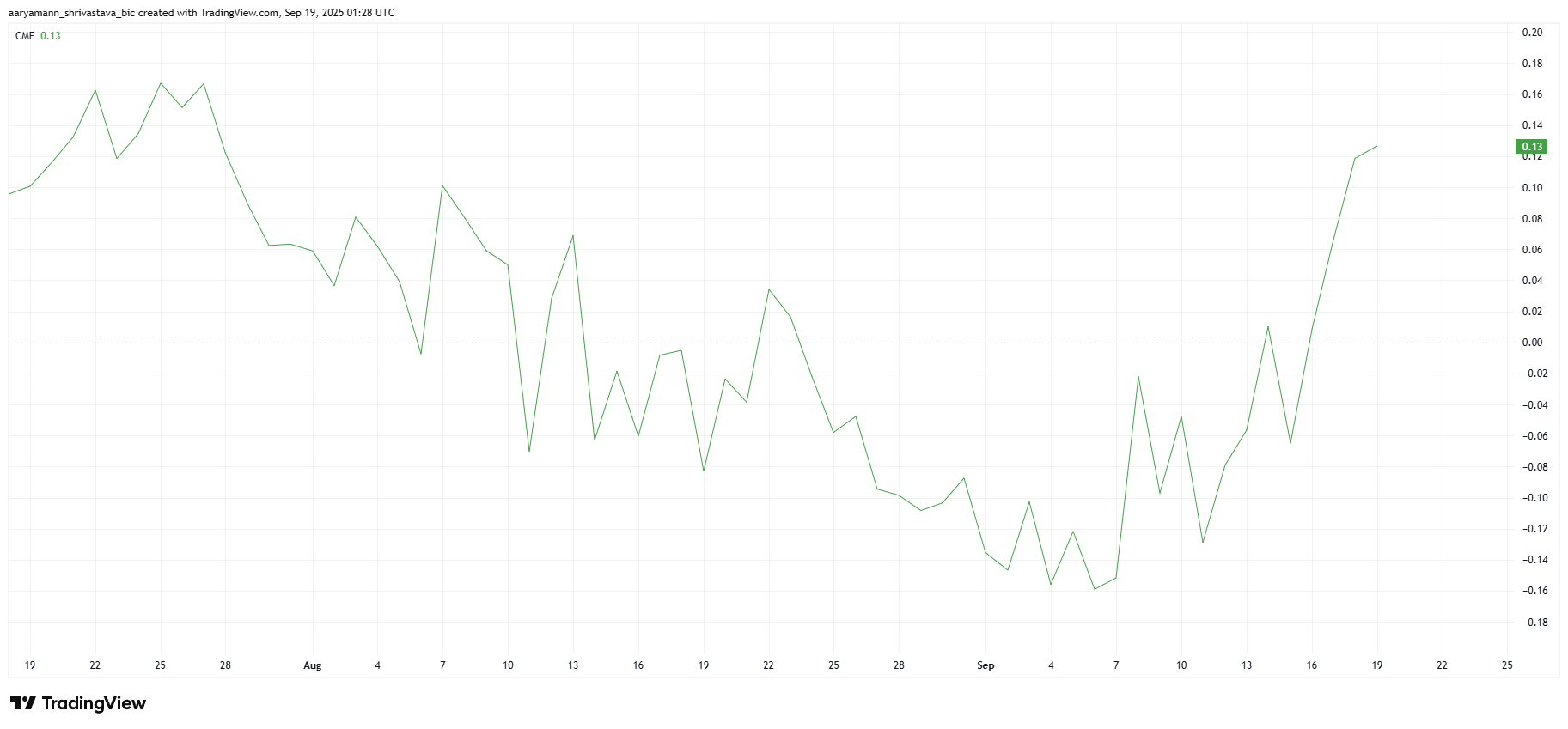
The upgrade will first roll out across three test networks throughout October before hitting the main Ethereum network. This careful testing approach aims to catch any bugs before millions of users and billions of dollars worth of transactions depend on the new code.
Testing Phase Begins in October
Before Fusaka reaches regular users, it must pass through rigorous testing on three separate networks. The Holesky testnet will be first on October 1, followed by Sepolia on October 14, and Hoodi on October 28.
These test networks let developers spot problems without risking real money or breaking live applications. Each testnet serves as a checkpoint where teams can verify that everything works as expected before moving to the next phase.
Developers note that exact epoch numbers and timing will be confirmed in the coming days.

Source: @christine_dkim
The development team has already frozen the code on September 22, giving their validation team time to run thorough checks. Client releases are scheduled for September 25, giving node operators time to prepare their systems.
What Makes Fusaka Special
Fusaka brings 11-12 technical improvements focused on making Ethereum faster and cheaper to use. The centerpiece feature is called PeerDAS (Peer Data Availability Sampling), which lets network validators check transaction data more efficiently.
Think of PeerDAS like quality control in a factory. Instead of inspecting every single product, workers check random samples to make sure everything meets standards. This approach saves enormous amounts of computer storage and internet bandwidth while keeping the network secure.
The upgrade also doubles the size limit for smart contracts from 24KB to 48KB. This gives developers more room to build complex applications without splitting their code across multiple contracts. New computer instructions will make certain operations run faster, especially those involving cryptography and data compression.
Massive Capacity Boost Coming
One week after Fusaka launches, developers will activate the first of several “Blob Parameter Only” updates. These changes will dramatically increase how much data the network can handle.
Currently, Ethereum processes 6 to 9 “blobs” of data per block. The first update will raise this to 10-15 blobs, followed by another increase to 14-21 blobs one week later. According to multiple sources, the second BPO fork is scheduled for January 7, 2026. Preliminary analysis suggests blob capacity could more than double within two weeks of activation.
These blobs are crucial for Layer 2 networks like Arbitrum and Optimism, which process transactions faster and cheaper than the main Ethereum chain. When the Dencun upgrade introduced blobs in March 2024, some Layer 2 networks saw their monthly costs drop from $15,000 to $1,500.
The capacity increases should make Layer 2 networks even cheaper to use while handling more transactions. Researchers estimate that by 2026, these improvements could help Ethereum process up to 12,000 transactions per second across all its layers.
Security and Stability Focus
The Ethereum Foundation has launched a four-week security audit with up to $2 million in rewards for researchers who find vulnerabilities. This bug bounty program runs until the December launch, giving independent experts time to probe the code for weaknesses.
Current testing shows promising results. Devnet 3, one of the early test networks, has maintained over 96% validator participation with only minor issues. The development team continues tracking problems through their dedicated bug monitoring system.
Fusaka also includes stronger anti-spam measures to prevent bad actors from flooding the network with junk transactions. These protections make it more expensive to spam Ethereum while keeping costs steady for normal users.
The upgrade maintains full compatibility with existing applications and wallets. Most users won’t need to take any action, as popular services will automatically integrate the changes. However, validators and node operators must update their software before each network upgrade to avoid penalties.
Strategic Timing and Market Impact
Fusaka arrives just seven months after the Pectra upgrade in May 2025, showing Ethereum’s commitment to faster development cycles. This timing puts Ethereum ahead of schedule for its six-month upgrade target.
The December 3 date was chosen strategically to align with the Devconnect conference in Buenos Aires, where Ethereum developers gather to plan future improvements. The upgrade positions Ethereum for stronger institutional adoption as companies look for scalable blockchain solutions.
Market analysts see Fusaka as a key driver for Ethereum’s growth in 2026. The combination of lower costs, higher capacity, and improved efficiency could attract more developers and users to the platform. Some experts predict the improvements could help push Ethereum toward new price highs as adoption increases.
The Road Ahead Looks Bright
Fusaka represents more than just another upgrade—it’s a foundation for Ethereum’s next growth phase. The improvements focus on infrastructure rather than flashy new features, reflecting the network’s maturity and focus on practical solutions.
With testing already showing strong results and a clear timeline in place, Ethereum appears on track for its most significant scaling improvement since the Merge in 2022. December 3 marks not just another upgrade date, but potentially the beginning of Ethereum’s transformation into a truly global-scale platform.


 1 hour ago
3
1 hour ago
3 










 Bengali (Bangladesh) ·
Bengali (Bangladesh) ·  English (United States) ·
English (United States) ·